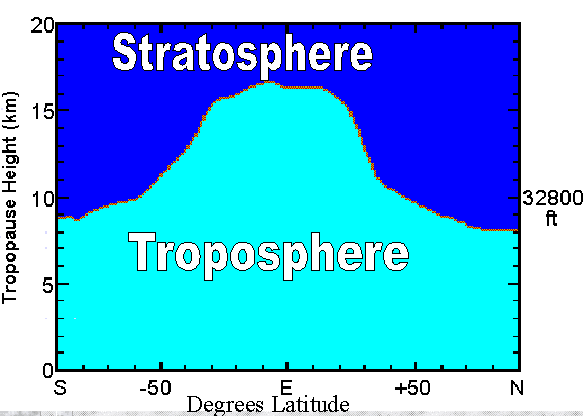Tropopausing
Eli has been fooling with his Spectra Calc Carrot. This started as an effort to see where the mixing ratios of carbon dioxide exceeds that of water vapor, which as you can see below, ranges from 5 km to about 10, depending on location and time of year. The mixing ration for CO2 is constant in the troposphere and stratosphere (and even higher)

but the bunnies found something interesting, which we assume is well known to those who actually work on this stuff, but whose implications have yet to become clear. The thickness of the region of lowest temperature between the troposphere and the stratosphere is greatest at high latitudes and thinnest at the equator.
Thursday, July 19, 2007
Subscribe to:
Post Comments (Atom)





5 comments:
Somewhere I read that stratospheric H2O was increasing. Not good news if true.
But why is the tropical stratosphere so much colder? (25K!).
I should have asked: "Is there a simple explanation for why the tropopause is colder, higher, and sharper in the tropics?"
Stratospheric h20 is rising for two reasons, Eli is not sure about the relative importance of each.
First, there is more methane in the atmosphere, and a certain amount gets into the stratosphere before it decomposes to CO2 and H20 through a chain of reactions started by reaction with OH. Photolysis high up in the stratosphere leads to H2O.
Second, the tropopause is warming so more water vapor makes it through.
CIP - the "simple" explanation is that in the stratosphere, air rises in the tropics and moves towards the winter pole, where it descends (the "Brewer-Dobson circulation"). This also explains why the ozone layer gets thicker as you move away from the tropics to high-latitudes.
Of course, that explanation just pushes the question down one level, since it doesn't explain *why* the stratosphere circulates in this fashion. That turns out not to have a simple answer - there's a fairly detailed explanation in Chapter 6 of the online "Stratospheric Ozone" textbook that Eli has on his list.
-- Robert P.
Eli and Anon,
Thanks. That helps a lot. If I understand correctly, there are two drivers for the Brewer-Dobson circulation - thermal pumping in the tropics and momentum pumping in the mid-latitudes from planetary waves. Does that sound right?
Post a Comment